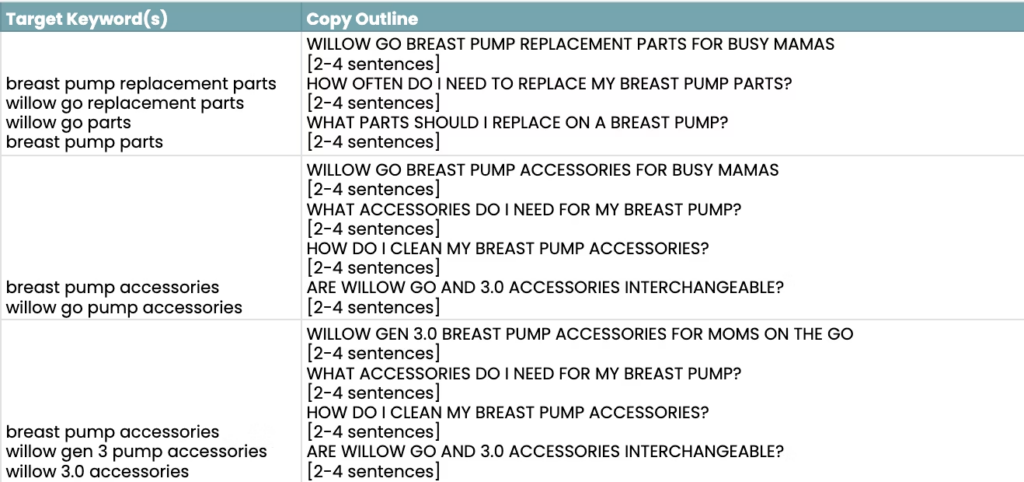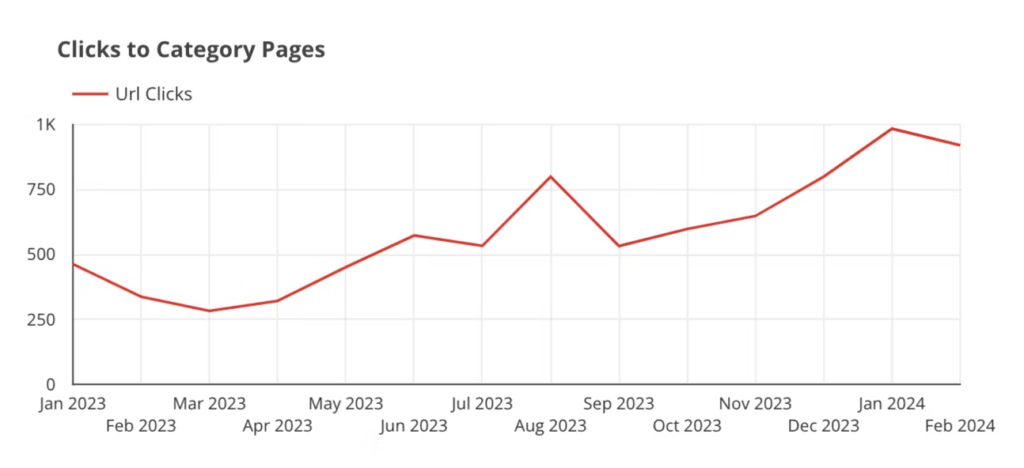Table of Contents
Category pages are some of the most important pages on an E-commerce website. They organize products into comprehensive grids, act as shopping hubs for site visitors, and can play a key role in your E-commerce SEO strategy. Don't sleep on category pages, folks.
If you've covered your technical bases and updated metadata, you shouldn't stop there. Adding content to these pages can significantly boost keyword visibility, traffic, and revenue.
Category page content is a tactic we use across E-commerce clients. In a nutshell, this content typically appears as a content block that lives at the bottom of the page. The content targets key shopping terms for the page and may include internal links, blog snippets, and more. We add it to the bottom of the page since people are visiting these pages to shop first. But, the content should still be useful for shoppers.
In this blog, we'll cover how to create great category page content. We'll also chat through how to get project buy-in from your boss or other stakeholders. Let's get started!
6 Tips for Creating Great E-commerce Category Page Content
Here's how we approach category page content at Uproer:
1. Choose Your Target Keywords
If you haven't already, you'll want to map a primary keyword to each of the category pages you're optimizing, along with a handful of secondary keywords. We won't go into a step-by-step keyword research guide here, but you'll want to pay attention to:
Search Intent
Search intent is the underlying goal a person has when they type a keyword into their search bar. Since you're optimizing category pages, you'll likely want to target keywords with high transactional intent. You can identify intent by investigating what types of sites are ranking for the keywords you're interested in targeting. For example:
The SERP for the keyword "coffee tumbler" is filled with other product pages, plus Google's shoppable grids.

The SERP for "best coffee tumblers" is more informational, filled with product guides and Reddit forums:

You can manually analyze search intent, or use a tool like SEMRush's Keyword Overview feature. To learn more about search intent and the crucial role it plays in understanding ranking volatility, check out Lily Ray's article: The Impact of Core Updates and Search Intent on Your SEO.
Organic Competitors
If you used the striking-distance method to identify priority pages to optimize, you can also take a look at the sites outranking you for those keywords. Plug their URLs into a tool like Ahrefs to see what their top-performing keywords are. Then, review their category page content to understand what you'll need to do to outrank them.
2. Gather Messaging Guidelines & Product USPs
Part of looping the brand experience team into this project is ensuring you have accurate messaging guidelines for the product that you're writing about. We typically collect this information at the beginning of an engagement for content production.
In addition to collecting brand and messaging guidelines, consider holding a stakeholder interview with a sales or marketing representative. The goal of this conversation is to gain a deeper understanding of what sets the product apart from competitors'. Just like any content that goes on a website, strive for content that is unique and valuable.
3. Outline Content Before Writing
Just as you would for an article, create an outline of what you want the category page content to say before writing. This is something you can run past the client before writing as well. Determine an estimated word count based on top ranking pages. Here's what this looked like with Willow Pump:

4. Use Blog Snippets
For additional content, use blog snippets to enhance your copy. We used this tactic as an internal linking strategy for an E-commerce client that sells insulated tumblers. Our top category pages acted as topic hubs for blog content. Then, we created bottom-funnel content that pointed to these category pages. We used snippets from these blogs on the category pages to enhance the copy and point back to the blogs, establishing a relationship between the pages.

5. Make Sure SEO Best Practices Are Implemented
Before hitting publish on your category page content, make sure all your SEO best-practice boxes are checked. Here are the primary things to consider:
- Heading hierarchy: Make sure your category content headings follow the correct hierarchy structure. There's no need to use an H1 here since each page should have only one.
- Crawlable content: If you're using any features to make your content more interactive, like a drop-down menu, ensure that the content can be found by search engines. You can do this by testing similar features on other pages using an extension like View Rendered Source. Check out Griffin's article on how to use this extension and other tools to diagnose JavaScript issues.
- Avoid keyword stuffing: Make sure keywords are naturally incorporated into the copy. While category page content is an SEO tactic, your content should flow with the rest of the brand copy and the page. Keyword stuffing to give the page a boost can create a negative user experience and ultimately hinder your ranking ability.
6. Create a Revisit Schedule
Category content isn't something you hit publish on and forget about. Treat these page updates like you're refreshing blog content. Revisit after 2-3 months, make edits, and update based on performance. You may find new sections and keywords to add over time that will help the page perform even better.
How to Get Buy-In for Category Page Content
Whether you work at an agency or in house, you'll likely need to get project buy-in from someone on your team. For a time-intensive project like category page content, creating an organized plan at the beginning can ensure there are no hiccups or questions as you get started.
Identify Priority Pages
You may have an idea of which pages you want to focus on, but you'll want to have some data behind the recommendation. Here are a few of the ways we prioritize pages:
Striking-Distance Keywords
Striking-distance keywords are keywords you rank outside of the top ten on search results. Using tactics like category page content can give them the extra boost they need to get to the top ten.
Here's how to prioritize by striking distance using a tool like SEO Monitor:
- Create keyword folders for each category page. Include 10-15 target keywords in each.
- Analyze ranking position data. Look for patterns where keywords are below the top ten and increasing in ranking position.
- Review the SERPs for your striking-distance keywords. Identify which pages could use some extra content.
- Create a priority list. Pages that rank first for their target keywords, or below striking distance, are lower priority.
Revenue & Traffic
Layering data over your striking-distance list can strengthen your page update recommendation. To do this:
- Use a tool like GA4 to pull your traffic and revenue data for each category page.
- Use a spreadsheet to layer the data against the priority list you've already made.
- Filter by revenue or traffic and use that to further drill down your priority list.
Do Some Napkin Math
A little napkin math never hurts if you want to take your recommendation to the next level. You'll want to answer the question: If this page ranked in the top three for the target keyword, how many extra clicks would we get?
Use a form of keyword forecasting to get there. For example:
- Use a tool like Ahrefs to pull search volume for your target keywords.
- Use a tool like Advanced Web Ranking's Organic CTR tool to look at CTR history for top competitors.
- Take the search volume of your target keyword and multiply it by the CTR of the position you're forecasting to reach (Search Volume x CTR = Estimated Clicks).
- Compare with the amount of clicks you're currently getting for the target keyword.
- Create a statement that answers your original question: "If the page ranks in the top three for this keyword, we'll receive an additional 73 clicks per month." Tip: You can also use keyword conversion data from your Paid Search team to create ballpark revenue estimates.
Show Competitor Examples
Have you ever presented to a room of people who only have a slight idea of what your job is? If you work in SEO, chances are you have. But the one thing these people have in common? The desire to be at the top of their industry. That's why pointing a finger at your top competitors is one of the best tactics you can use to get buy-in.
Before you recommend category content, create a document that outlines the "why" behind the project. Use a few competitor examples and data points to strengthen your recommendation. If you're able to link a tactic to actual results, your recommendation will seem like a no-brainer to your client.
Here's an example of how we did this with our client, Willow Pump:

Loop in the Brand Team
Brand teams will often have concerns with adding new "SEO content" to pages, especially if it doesn't fit with their original page-design vision. Turning this into a collaborative process and outlining the value can help you get buy-in.
When we wrote footer content with Willow Pump, we treated it the same as our traditional content workflow. We looped in their marketing and brand teams and outlined the content before writing. After we drafted the copy, we had their brand team review and approve the copy before publishing.
By treating this as a collaborative process, we've been able to nurture an ongoing relationship with Willow's internal brand copywriters. Read more about how this engagement helped us land a spot on the US Search Awards Shortlist!
Create Category Page Content That Drives Results
If you want to move the needle, category page content is a great way to do so. Check out some of the results we've seen while using this tactic:
Insulated Drinkware Company
Our client makes insulated drinkware and has several collection pages targeting competitive, non-brand keywords like "coffee tumbler." We created a priority list for these pages by organic revenue, then executed eight category page updates per month. After beginning this tactic in 2023, collection pages saw a 15% increase in organic traffic, and a 21% increase in organic revenue Y/Y. We're now ranking on the first page, if not in the top three, for a wide variety of high volume, competitive product keywords.

Wearable Breast Pump Company
Our wearable breast pump client had several collection pages without content on them. As an initiative to drive visibility to their shop pages, we executed a series of category page updates that had immediate positive effects on traffic and keyword visibility.

Category page content is an excellent tactic to have in your E-commerce SEO tool belt. Want to learn more about what you can do to give your E-commerce site some extra love? Book an intro call with Uproer today, we're here to help!

